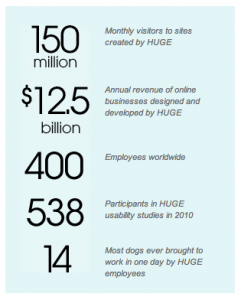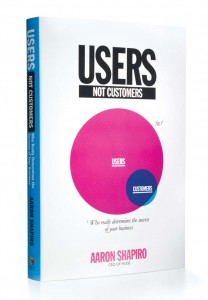 With a client roster that read’s more like a Marketers’ holiday wish list, Aaron Shapiro and his global digital marketing agency HUGE have been instrumental in building and developing digitally-driven businesses since 1999. From Ikea to Jet Blue, Mastercard to the New York Times and so many others, I can almost guarantee you have experienced and benefitted from their dedication to digital strategy and the user experience. As a matter of fact, one of their projects is currently part of Pop Culture. Partnered with Pepsi’s digital engagement team, HUGE completed the visual design, user experience design and development for the X-Factor’s PepsiSoundOff.com. The platform, which supports Pepsi’s premiere sponsorship of the hit TV show is designed to enhance fans’ viewing experience and uses gaming mechanics to encourage fans to share their opinions about the show in real time.
With a client roster that read’s more like a Marketers’ holiday wish list, Aaron Shapiro and his global digital marketing agency HUGE have been instrumental in building and developing digitally-driven businesses since 1999. From Ikea to Jet Blue, Mastercard to the New York Times and so many others, I can almost guarantee you have experienced and benefitted from their dedication to digital strategy and the user experience. As a matter of fact, one of their projects is currently part of Pop Culture. Partnered with Pepsi’s digital engagement team, HUGE completed the visual design, user experience design and development for the X-Factor’s PepsiSoundOff.com. The platform, which supports Pepsi’s premiere sponsorship of the hit TV show is designed to enhance fans’ viewing experience and uses gaming mechanics to encourage fans to share their opinions about the show in real time.
Even with that small snippet of background, it’s an easy conclusion that this interview is HUGE, and might be one of the best to date. This is not only because having a digital strategy is beyond relevant to all businesses these days, but mainly due to the generous knowledge sharing Aaron has provided to help us all be better in these endeavors and enhance the user experience. I am very grateful to Aaron for taking the time to engage with PMC, and as well to Sam Weston, Director of Communications at HUGE, for his help. Visit the site, check out the book, and enjoy this interview…
DC: Who is Aaron Shapiro and what does he do?
 AS: I’m the CEO of HUGE, a digital marketing agency that helps global companies reimagine how they interact with their customers and manage their business in the online economy. I’m also author of a new book, Users Not Customers, a strategy book about how companies can transform themselves to be successful in our (digital) economy. Before HUGE I had stints as a technology entrepreneur, venture capitalist, and management consultant.
AS: I’m the CEO of HUGE, a digital marketing agency that helps global companies reimagine how they interact with their customers and manage their business in the online economy. I’m also author of a new book, Users Not Customers, a strategy book about how companies can transform themselves to be successful in our (digital) economy. Before HUGE I had stints as a technology entrepreneur, venture capitalist, and management consultant.
DC: How important is a digital strategy, and what is the first step to formulating one?
AS: A digital strategy is critical for businesses to survive and thrive in today’s economy. Digital media and technology is disrupting industries across the gamut from books to music, movies, retail, travel, direct marketing, telecommunication, and even the auto and healthcare sectors. In 2012, half of all retail purchases in the United States will be influenced by or transacted on the Internet, and this figure is only slated to grow. If a company is not ready to interact with its consumers online or through mobile phones, and to meet the particular needs of the users of this technology, they will most likely wither and fall under the weight of the newest tech-savvy competitor in the marketplace. This is what happened to businesses like Blockbuster, Borders and Circuit City, and it’s going to happen to many more large, well-known businesses in the future.

The first step to formulating a digital strategy is for company leadership to wholeheartedly commit to executing one. They need to hire or promote someone who is an expert in digital, user behavior and business and give this person the authority to make great changes across the organization.
DC: How does Social Media fit into a digital strategy?
AS: Social media is one relatively small piece of the whole equation. A company’s digital strategy ideally doesn’t solely cover consumer touch-points; it aligns internal operations to optimize the many facets of external communications. Marketing is one of the external touch-points; others are the product itself, sales, and customer service. Social media is integral to the marketing piece, however. Users of digital media don’t want to be distracted by irrelevant advertising and shouldn’t be expected to hunt down brands in order to form an impression of them. This means brands must integrate themselves into existing user behavior. When it comes to social media, users are sharing. Therefore brands must provide users with something worth sharing—that sounds obvious but many brands falter by prioritizing their messages over the tools or content the user would actually value and be inspired to share.
DC: A huge segment of my audience is in the Print Industry. Do you think it’s a conflict to embrace a digital strategy to ultimately sell Print?
AS: It’s not a conflict at all, it’s a necessity. Readers of print magazines are the same people surfing the web. Therefore it would benefit any print publisher to promote itself online and to present its readers with a user-friendly experience. In my book Users Not Customers I discuss in depth how the Readers Digest Association and Penton Media have handled the digital revolution. And for those companies outside of the magazine business, digital can be an effective tool to sell print—after all, most companies will first look for a good print partner by researching online.
DC: How can Print and Digital work best together to help companies achieve their goals?
AS: I find that marketing solutions that combine print and digital can be extremely successful. Digital is certainly growing in ubiquity, but print is by no means going away. It’s about delivering the right message where audiences are —and sometimes they’re online, but they’re also reading magazines, opening print mail, and so forth.
 DC: You have just written a book titled Users Not Customers, can you explain what you mean by that.
DC: You have just written a book titled Users Not Customers, can you explain what you mean by that.
AS: I mean that adages like the “customer is king” are out of date, and that to succeed in today’s digitally driven economy, business leaders must prioritize users, the people who interact with them through digital media and technology, often without first spending a dime. Users are making consumer and enterprise purchasing decisions. Users are members of the press, job candidates and employees. Users are business prospects and future partners. Users are your customers, too—although with a significantly different set of expectations than that of customers 20 years ago, pre-Internet. Ignore the sensibilities, interests and needs of users, and risk imminent irrelevance.
DC: If readers took only one thing to heart after reading your book, what would you want that to be?
AS: I can’t stress how important it is for companies to have an effective digital strategy—the world is moving to digital, and if you’re not effective in that arena, your organization’s very survival is at stake. The way to be successful online is to focus users, the people who interact with through your company’s digital footprint. Focus on meeting users needs, and making great user experiences, and success will follow.
DC: You have had many prestigious honors, more recently Online Media, Marketing and Advertising named HUGE 2010’s Social Media Agency of The Year, Advertising Age placed HUGE on of its A-List of hot agencies to watch (for the second year in a row), and you are one of Crain’s 2011 Top 40 under 40. With all that success, what have you learned from the things that haven’t gone so well?
AS: I’ve learned you can’t be afraid to try things, fail quickly, and iterate – in my business it takes a lot of trial and error until you get to what works. You don’t make something great by building out the first design just to get it done or by avoiding trying new things for fear of failure. You have to accept risk-taking as part of the job, to see it not as something jarring, but as something that’s to your advantage. Second-rate, me-too products and experiences, those come from businesses that discourage trial and error.
DC: Lastly, if you were to give a commencement speech at either Columbia or Harvard, both from which you hold a degree, what would your message be regarding the future of digital marketing and trends to be aware of before it’s too late.

AS: There’s a poster on our office wall, which says “make something you love”. To me, that’s the secret to success in digital marketing, in business and also personally. Push yourself and your team to create exceptional digital products and experiences. This means designing something and then throwing it all away to try to make it better. It means constantly challenging yourself to see if the experience can be easier, more beautiful, simpler, more elegant, more in tune with what people will embrace. It’s a painstaking undertaking that means sweating all the details, because your heart and soul is in it, and because it becomes your baby and you want it to be absolutely perfect. It should be so special that in forty years you’ll look back and be proud that you were part of it. It’s the key to business success, a company’s ability to compete in today’s digitally-driven economy, and it’s the key to a rewarding, fulfilling career and personal happiness.
Connect with Aaron and HUGE…











